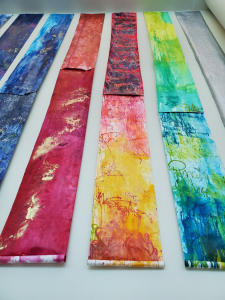122 Conversations – A Weekly Letter from Rabbi Davis – February 21, 2020
Shalom Chaverim
I was recently at the airport (Terminal 2) where I saw a wonderful piece of art. It is called 122 Conversations by St Paul artist, Anne Labovitz. Labovitz reached out to people all around the world from Duluth’s sister cities in Canada, Sweden, Russia, Kurdistan, and Japan. They discussed a variety of topics such as generosity, friendship, and community. Inspired by these encounters, she created 70 large-scale, colorful scrolls. In the words of the exhibit, “Labovitz manifests these conversations with graffiti-like text lines, each mark individually created as a response to the revelation that personal experiences create global connections.”
Labovitz reached out to people all around the world from Duluth’s sister cities in Canada, Sweden, Russia, Kurdistan, and Japan. They discussed a variety of topics such as generosity, friendship, and community. Inspired by these encounters, she created 70 large-scale, colorful scrolls. In the words of the exhibit, “Labovitz manifests these conversations with graffiti-like text lines, each mark individually created as a response to the revelation that personal experiences create global connections.”
Looking at the works, I wondered how did Labovitz move from conversation to color? She explains that certain words have “visceral connotations” and she felt compelled to put them on canvas. These scrolls are thus what she calls word-portraits. But they are more than just records of conversations. They capture the experience of encountering another. In those “moments that billowed between us,” she explains, “there was a beautiful opening and I fell in love with each of the interviewees. In those moments, there was expansion. That’s what you see in the paintings.”
I imagine something similar occurred at Sinai.
I don’t know if Labovitz intended it, but I hear in her language and see her art deep spiritual/religious resonance. On the surface, there is her use of scrolls, the language of “revelation,” and the number 70 (in Jewish tradition, God spoke and God’s words were divided into 70 languages corresponding to the 70 nations of the world). All remind me of Torah.
But association goes deeper than that. Labovitz describes an authentic encounter with another. At Sinai, it was a sacred encounter with the ultimate Other.
 The Torah describes the experience as sensory overload. There was lightning and thunder, smoke and fire, and a wonderful fragrance filled the air. I usually picture the sky like the ominous heavens of an El Greco landscape. But Labovitz’s scrolls makes me think that perhaps instead, the heavens were a brilliant hue of swirling colors. And indeed, the Torah tells us that Moshe looked and saw that the throne of God rested on sapphire pavements, “radiant like a pure, cloudless sky” (Ex. 24:10).
The Torah describes the experience as sensory overload. There was lightning and thunder, smoke and fire, and a wonderful fragrance filled the air. I usually picture the sky like the ominous heavens of an El Greco landscape. But Labovitz’s scrolls makes me think that perhaps instead, the heavens were a brilliant hue of swirling colors. And indeed, the Torah tells us that Moshe looked and saw that the throne of God rested on sapphire pavements, “radiant like a pure, cloudless sky” (Ex. 24:10).
Beyond color of the sky and the “voices the Israelites saw!” (Ex. 19:15), as with Labovitz, for the Israelites revelation was an opening. It was a state of expansion. It was what Jewish mystics call mochin d’gadlut, expanded consciousness. In that moment, they felt more connected to each other. And they fell in love with God. Such is the power of an authentic encounter, of holy listening, of being completely present with another.
Martin Buber, in his classic I Thou, captures this notion that separation can give way to unification when boundaries between people melt away: “Every It is bounded by others; It exists only through being bounded by others. But when Thou is spoken, there is no thing. Thou has no bounds.”
In other words, sometimes we relate to a person as an object. We say, “What can you do for me?” We treat them like an “it”- a Swede, a Russian, a Kurd, etc. If instead, we put aside our preconceptions and projections, if we encounter them in the fullness of their personhood, we “breach the barriers of a lofty solitude.” That which divides and separates us falls away. We discover an expanded space between us that we share. And in that space grows love and a sense of responsibility I for a Thou.
Buber writes, “all real living is meeting.” When we fully encounter another and The Other not as an object for use but another with whom to share a moment, we become fully human and the space between us becomes truly holy.
Bivrakha,
Rabbi Alexander Davis
adavis@bethelsynagogue.org
